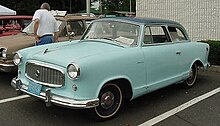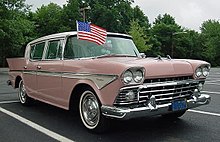Rambler (make of car)
Rambler ( English for hikers ) was a brand for vehicles from the time after the Second World War .
prehistory
The Thomas B. Jeffery Company had already used this brand name between 1902 and 1910 . Nash Motors took over the company in 1917 and came into possession of the brand.
history
1950–1957 (model name)

Under the direction of George Mason , Nash began developing a small car that could be manufactured cheaply for the post-war market.
However, the shortage of steel limited the amount of raw materials Nash could get. Mason changed the compact car - now known as the Rambler - into a two-door convertible sedan , which was fitted with many details as standard that were typically ordered as special equipment. In this way he maximized the company's profits. When this model was introduced, the Rambler became an instant hit for Nash. When the steel shortage caused by the Korean War subsided, the Rambler model range was expanded to include a four-door sedan and a station wagon , both of which became just as successful as the two-door convertible sedans .
The first generation of the Nash Rambler wore the modified styling of the Nash Airflyte , which had covered front wheels, among other things. This construction detail reduced the air resistance of the car, but limited the steering angle of the front wheels, which resulted in a larger turning circle. The Ramblers were built in this way until 1955, when the front wheel covers were dispensed with as part of a facelift .
In 1954 the American Motors Corporation (AMC) was founded through a merger of Nash-Kelvinator with the Hudson Motor Car Co. Then the Ramblers were sold under the Nash and Hudson brands, but did not differ externally. The Nash and Hudson brand names were retained until 1957, when all AMC cars became Ramblers, with the exception of the imported Metropolitan 1958–1962.
1958–1970 (car brand)
Between 1958 and 1970, Rambler was considered a car brand.
At the beginning of the 1960s, George W. Romney (successor to Mason) decided to further differentiate the Rambler series: in 1962 the Ambassador was officially added as the best-equipped model (previously it was marketed as "Ambassador by Rambler") and the earlier ones Rambler Six and Rambler Rebel V8 became the Rambler Classic .
Romney also brought in his plan to cut production costs, which required more common parts for the Ambassador and Classic models. From 1962 onwards, all big Ramblers shared the same chassis and body; only equipment details differentiated the Classic and the Ambassador. The 1963 Ambassador / Classic models and 1964 American models even had many deep-drawn parts in common.
In 1963 the Rambler model series was awarded the “Motor Trend of the Year” award. Romney's departure (he became governor of Michigan ) opened the door for his successor, Roy Abernethy , who brought the company back into competition with the "Big Three" ( General Motors , Ford and Chrysler ) with many chassis and bodies.
One of his first measures was the design of the 1965 Rambler series, in which the Classic was clearly different from the Ambassador, although they still had many parts in common. In addition, AMC manufactured the Marlin , a hardtop coupe that AMC put a foot in the door of the sporty fastback market.
Supported by marketing reports, Abernethy presented the argument of the AMC owners' meeting as the next step that the Rambler had not only acquired an indigestible image over the years, which turned out to be a sales obstacle, but that consumers also equated this name with compact cars. American Motors then began to extinct the name Rambler in favor of the name AMC in 1966, as the company wanted to become a manufacturer of cars of various sizes. This later turned out to be a mistake. The return to the brand name Rambler and the association of customers with economical compact cars could have benefited AMC in the 1970s.
In 1968 the only car that was named Rambler at AMC was the compact Rambler American , and during its final year of production, 1969, it was named Rambler only.
1970–1983 (model name)
The Rambler brand was continued in various international markets: For example, the AMC Hornet and AMC Matador assembled from CKD kits by Australian Motor Industries (AMI) were sold as Ramblers until 1978. This brand name was last used by Vehículos Automotores Mexicanos SA (VAM) in Mexico .
In Argentina at IKA Renault , the Rambler American in 1967 became IKA Torino . This later became the Renault Torino , which was offered until 1980.
Pop Culture
The Rambler has also been mentioned in music, television, and films. Here some examples:
- Lois Lane drove a 1951 Rambler Custom Landau (Cabriolet) in the 1953 TV series Superman .
- The little car is the theme of the song "Beep, Beep (The Little Nash Rambler)" by The Playmates .
- A rambler appeared in episode 9 of the second series of Prison Break .
- Fred from Cars appears in a Rambler.
- A 1958 Rambler hardtop coupe appears in Cyndi Lauper's music video "She Bop" .
- A 1959 Rambler Super appears in episode 7 of the second series of The Sopranos .
- In “3rd Rock from the Sun”, the Solomons own a Rambler Cabriolet from 1962.
- The band Diesel mentions the Rambler in their 1981 hit "Summernight in Sausalito"
literature
- George Nicholas Georgano (Ed.): The Beaulieu Encyclopedia of the Automobile . Volume 3: P-Z . Fitzroy Dearborn Publishers, Chicago 2001, ISBN 1-57958-293-1 , pp. 1295-1296 (English).
- John Gunnell (Editor): The Standard Catalog of American Cars 1946–1975. Kraus Publications 1987, ISBN 0-87341-096-3 .
Web links
- The AMC Rambler Car Club (English)
- The Nash Car Club
- The story of the Rambler on amcrc.com
- Nash Car Club of America's Pacific Northwest Region
- History and documentation of the AMC / Rambler on AMCyclopedia (English)
Individual evidence
- ↑ George Nicholas Georgano (Ed.): The Beaulieu Encyclopedia of the Automobile . Volume 3: P-Z . Fitzroy Dearborn Publishers, Chicago 2001, ISBN 1-57958-293-1 , pp. 1295-1296 (English).

